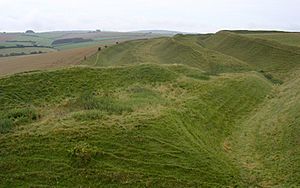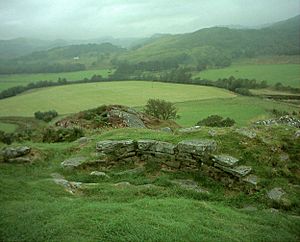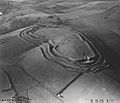Hill fort facts for kids
A hill fort is an old type of fortified place or settlement. People built them on hills or high ground. This was done to get a military advantage. The fort's shape usually followed the hill's natural curves. They often had one or more lines of earthworks, which are big ditches and banks. They might also have had stockades (wooden fences) or strong walls, plus outer ditches. Maiden Castle in Dorset, England, is a famous example. It's one of about 1000 hill forts built in Britain during the Iron Age.
Contents
What is a Hill Fort?
A hill fort is an ancient place where people lived or took refuge. It was built to be safe from enemies. These forts were usually on a natural rise in the land. This high spot gave them a great view of the surrounding area. It also made it harder for attackers to reach them.
How Were Hill Forts Built?
Hill forts were designed to be very strong. Their defenses usually followed the shape of the hill. They often had several layers of protection. These layers included large earthworks, which are huge banks of earth and deep ditches.
Many hill forts also had tall stockades or strong defensive walls. These walls were often made of wood or stone. Outside these walls, there were usually more ditches. At places like Maiden Castle, the inner rampart was very tall. It was about 14 meters (46 feet) high. This rampart had a fence of huge, upright timbers on top. It was also covered with large limestone blocks. The entrances had massive timber gates.
When Were Hill Forts Used?
People started building hill forts a very long time ago, even in the Stone Age. However, they became much more common in later periods.
Some key periods when hill forts were widely built include:
- The Urnfield culture (around 1300 BC to 750 BC) during the Bronze Age.
- The Hallstatt culture (around 1200 BC to 500 BC), which was from the late Bronze Age to the early Iron Age.
- The La Tene culture (around 600 BC to 50 AD), which was during the late Iron Age.
Hill forts were very common across Europe. The Celtic people, for example, used them for a very long time. There were many different kinds of hill forts, showing how important they were for ancient communities.
Images for kids
-
Maiden Castle in England is one of the largest hillforts in Europe. Photograph taken in 1935 by Major George Allen (1891–1940).
-
The ramparts of the multivallate British Camp in Herefordshire
-
Hillfort Kostolec, Piešťany (Slovakia).
-
Hillfort at Coaña, Asturias, Spain
-
A ruins of the Unikonlinna hillfort in Janakkala, Finland
-
Exterior view of the Ringfort Grianan of Aileach situated in County Donegal
-
Piliakalnis complex in Kernavė, a World Heritage Site
See also
 In Spanish: Castro (fortificación) para niños
In Spanish: Castro (fortificación) para niños













